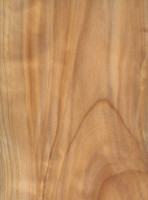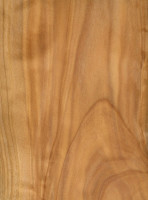 |
Common Name(s): Gowen Cypress Scientific Name: Cupressus goveniana Distribution: Endemic to coastal California Tree Size: 30-50 ft (9-16 m) tall, 1-2 ft (.3-.6 m) trunk diameter Average Dried Weight: 30 lbs/ft3 (480 kg/m3) Specific Gravity (Basic, 12% MC): .40, .48 Janka Hardness: 570 lbf (2,520 N) Modulus of Rupture: 8,250 lbf/in2 (56.9 MPa) Elastic Modulus: 653,000 lbf/in2 (4.50 GPa) Crushing Strength: 3,680 lbf/in2 (25.4 MPa) Shrinkage: No data available; most likely very similar to Monterey Cypress |
Color/Appearance: Heartwood is a pale yellowish or reddish brown. Narrow sapwood is paler and usually clearly demarcated from the heartwood.
Grain/Texture: Grain is usually straight, though small knots are sometimes present, creating a more irregular grain pattern. Fine, uniform texture with a good natural luster.
Endgrain: Resin canals absent; earlywood to latewood transition gradual, color contrast low to medium; tracheid diameter small to medium; parenchyma diffuse.
Rot Resistance: Rated as moderately durable; mixed resistance to insect attack.
Workability: Overall easy to work with hand and machine tools, though areas around knots can be problematic. Reportedly difficult to steam bend. Glues, stains, and finishes well.
Odor: Most cypresses in the Cupressus genus have a distinct, fragrant scent.
Allergies/Toxicity: Although severe reactions are quite uncommon, Gowen Cypress has been reported to cause skin irritation. See the articles Wood Allergies and Toxicity and Wood Dust Safety for more information.
Pricing/Availability: Because of its small size and very limited distribution, Gowen Cypress isn’t used for lumber commercially. Availability is likely to be limited to specialty/hobbyist projects outside of the tree’s natural range.
Sustainability: This wood species is not listed in the CITES Appendices, but is on the IUCN Red List. It is listed as vulnerable due to a population estimate numbering under 10,000 mature trees (which continues to decline), and because of a severely fragmented population. Gowen Cypress has also been protected under the United States’ Endangered Species Act since 1998.
Common Uses: Not generally used for lumber; other closely-related cypresses have been used for utility lumber, fence posts, musical instruments (flamenco guitars), furniture, boatbuilding, and turned objects.
Comments: Gowen Cypress is a very small tree (sometimes shrub-sized) that is endemic to coastal California and is considered endangered within its natural range. Often, it is found in association with Monterey Cypress.
- Alaskan Yellow Cedar (Cupressus nootkatensis)
- Leyland Cypress (Cupressus x leylandii)
- Mediterranean Cypress (Cupressus sempervirens)
- Mexican Cypress (Cupressus lusitanica)
- Monterey Cypress (Cupressus macrocarpa)
None available.
Scans/Pictures: There are currently no pictures of this exact wood species, but a similar species within the Cupressus genus is being substituted (C. macrocarpa). If you’d like to contribute a wood sample of this specific species to be scanned, (even small pieces of veneer can be sent), please use the contact form.



According to Wikipedia and certain other sites, this darn tree was reclassified recently as Hesperocyparis goveniana, In fact according to the US Forest Service, this took place in 2013 and previously, the thing was called by at least two other genus names including Neocupressus, and Callitropsis. Apparently they name it using the Wheel of Fortune. Here is the US Forest Service site about it: Hesperocyparis goveniana (usda.gov)
What type of wood is this ?? I was told it is Cypress ? The one on the left is what I was told was Cypress the piece on the right I have no idea, I think it is some variation of pine. ???